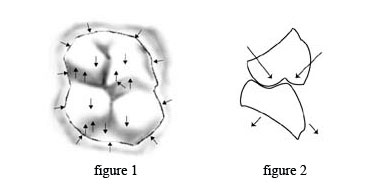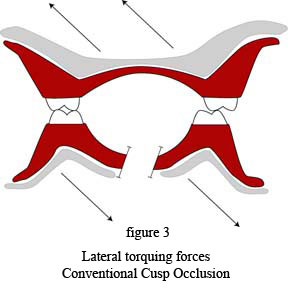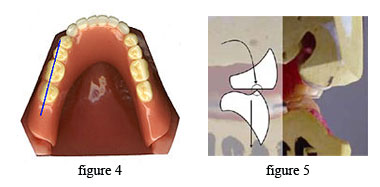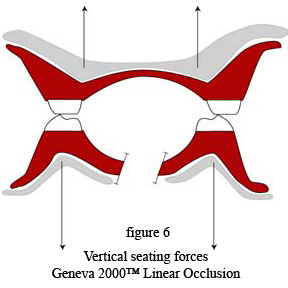Denture Stability
Conventional Occlusion vs. Linear Occlusion
Conventional Occlusion

Conventional dentures use a tooth design and occlusion called cusp occlusion that is based on the anatomy of natural teeth (figure 1). But there is a major difference between natural teeth and dentures, and that is that natural teeth have roots that are securely set into bone. With dentures there are no roots to secure the denture in place. The denture floats on the tissues of the mouth and relies on suction between the denture base and the tissues to hold the denture in place. But as the opposing top and bottom posterior teeth contact, the forces of this contact are exerted in various opposing angles due to the different contact points of the anatomically designed teeth (figure 2). With normal pressures exerted, the results of these opposing angles are bilateral imbalances creating torquing forces that cause the denture to tilt and/or dislodge (figure 3). The long-term results of this tilting of the denture base are detoriation of the jaws bony ridge. As this detoriation of the ridge occurs the denture base becomes unstable contributing to a cycle of instability. The only solution to this problem is Geneva 2000″

Geneva 2000"! Linear Occlusion

The concept of linear occlusion has been in existence for over forty years. It is defined as the occlusal arrangement of artificial teeth. They have a straight, long, narrow occlusal form resemblilng that of a line, (fig.4) usually articulating with opposing flat tooth (fig 5). With this in mind this design of tooth, the patient will be able to slide their jaw from front to back and left to right without dislodging the denture. You will have a 90° vertical seating force in the cradle of the lower jaw see (Fig 6). With conventional dentures the patient is unable to go through these functions and still maintain a stable lower denture. This type of design you will have no trauma to the tissue and bone, because you have no torguing forces as you do have with cusp occlusion dentures. People with all of their natural teeth can exert approximately four hundred and fifty pounds (450) lb.per square inch of pressure when they bite or chew. Full denture wearers generally can exert approximately thirty-five (35) pounds of pressure per square inch with conventional; or cusp occlusion, were as is with a Geneva 2000® dentures will increase to One Hundred thirty five (135) lb. Per square inch.
